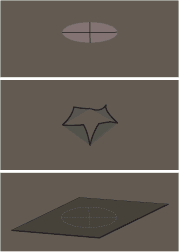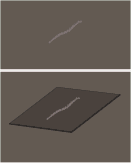Repairing flat roofs
finding the leak
repairing blisters - splits and tears - lifting overlaps - flashing - whole roof treatment
Safety: Working on a roof involves working at height (even on a bungalow), so always use scaffolding or other stable platform, never use just ladders. Don't walk on a flat roof unless you know that it is sound.
The first sign of a problem with a flat roof will probably be found in the room below, either with water actually dripping, or with signs of dampness in the ceiling.
Before stepping onto a flat roof, consider its strength - if the roof is old and has been leaking for some time, the roof timbers may have become rotten in areas.
Using a board to walk on will spread your weight and remember to take care when working near the edges of the roof as a fall may result from any slip.
If you have any doubts about a safe means of working on the roof, consult a professional roofer.
Finding the leak
The first step is to find the source of the leak in the surface of the felt. The leak in the top layer will probably not be directly above where the leak appears in the room; the water will be getting under the top layer of felt and then running between layers before finding a way through the boarding.
Start by looking at the overall condition of the flat roof covering. If it looks a mess and is torn, split or has otherwise deteriorated over a large part of the total area, consider replacing the whole roof. Whilst small, localised repairs to a generally serviceable flat roof are worthwhile, repairing roofing which has reached the end of its lifespan is just not economically worthwhile.
If the leak or dampness is adjacent to the wall, or pitched roof, abutting the flat roof, the first place to check for a leak is the along the flashing.
Otherwise, locate the position directly above the leak or damp area, then check up the slope of the roof for cracks, splits or blisters - pay special attention to any overlap of the roofing material. (A flat roof does have a slight slope, normally down from an abutting wall/pitched roof - up from the rain water guttering.)
Where the roof is covered with chippings, brush these away to enable a close look at the surface.
Cracks and splits may have been caused by the movement of the roof structure, this is not unusually as the heat of the sun will cause it to expansion and contraction - there is nothing to be done about this, the normal flexibility of the roof felt should accommodate this.
Blisters are normally caused by trapped air or moisture between the layers of the roofing felt expanding when heated by the sun. If found, they should be lightly pressed to check if the surface is broken - if the surface is sound it may be better to leave them undisturbed rather than risk introducing a problem.
Repairs
Various repair kits are on the market which contain adhesive and tape for making localised repairs. Use these in accordance with the manufacturer's instructions.
For any repair, always clean the area thoroughly removing any chippings and use a fungicide to kill any mould growth. A repair is best made after a long period of dry weather has allowed any moisture in the roof felt to dry out.
Blisters in the felt
 Carefully clean the surface over and around the blister of any chippings, mould and dirt. Use a sharp craft knife to make a cross cut through the top layer - don't use too much pressure. Peel back the four segments and dry the area underneath - careful use of a heat gun will ensure the area is dry, don't overheat any area of the felt as it may just melt away, keep the heat gun moving playing warm air over the whole area.
Carefully clean the surface over and around the blister of any chippings, mould and dirt. Use a sharp craft knife to make a cross cut through the top layer - don't use too much pressure. Peel back the four segments and dry the area underneath - careful use of a heat gun will ensure the area is dry, don't overheat any area of the felt as it may just melt away, keep the heat gun moving playing warm air over the whole area.
Apply some bitumen adhesive to the exposed surface and fold back the segments. Press down the top layer into the adhesive.
Cut a piece of new felt to use as a patch big enough to give above a 50mm (2 inch) overlap beyond the repaired blister. Apply some bitumen adhesive over the repair and beyond to suit the patch and apply it. Press the patch firmly into place and make sure that the edges are well sealed.
Splits and tears
 If the split or tear can be lifted without causing further damage to the felt, carefully lift it and clean out the space under. Also clean the area around it.
If the split or tear can be lifted without causing further damage to the felt, carefully lift it and clean out the space under. Also clean the area around it.
Fill the space under the lifted split/tear with bitumen adhesive and press it down. Fill any other voids with bitumen compound.
Cut a piece of new felt to use as a patch big enough to give above a 50mm (2 inch) overlap beyond the repaired split. Apply some bitumen adhesive over the repair and beyond to suit the patch and apply it. Press the patch firmly into place and make sure that the edges are well sealed.
Repairing lifting overlaps
If an overlap is found to be lifting, carefully lift it, clean out any dirt and water from underneath then allow it to dry thoroughly.
Fill the space under the lifted overlap with bitumen adhesive and press it down - you may find that the overlap tends to lift while the adhesive is drying, should this occur, try weighting the seam down whilst it dries.
If all else fails, fit a repair patch over the repaired overlap but make sure that there is plenty of adhesive along the seam to fill the difference in height between the levels of adjacent strips of felt.
Repairs to flashings
Where the flat roof abuts a wall there will be some form of sealing flashing - usually a zinc (or zinc substitute) strip.
The best way to repair this flashing is to use one of the proprietary self-adhesive repair tapes - follow the manufacturer's instructions.
Clean off the surface, cut the tape to length and apply it to the area - smooth it down onto the surface making sure that the edges are well sealed and the tape is not creased. Take care if fitting a long length as if you start positioning it at one end, any slight misalignment may put the other end out of position by a large amount. Where possible, someone holding the far end just off the surface will allow you to work along the length smoothing it down.
If you need to apply more than one horizontal strip of repair tape to build upwards, start with the lowest strip and overlap onto it with the next strip. Take care to ensure that the overlaps are well sealed at each end.
Whole roof treatment
Sometimes if there are a number of repair to be done, or if you want to increase the life of the whole roof anyway, an alternative is to apply a treatment over the whole roof area. Various products are available to suit this, the common ones being:
- Bitumen based - gives good coverage and can extend the life of the flat roof covering for 3 to 5 years.
- Mastic based, flexible non-setting, often fibre-filled to give added strength to the surface.
- Acrylic based - some claim up to 10 years life and some are formulated so that they can be applied in wet conditions.
Various other methods are available but often only via a roofing contractor.
Generally the procedure is to brush off all loose material from the roof and apply a fungicide to kill off any mould etc.
Allow the roof to thoroughly dry and apply the sealant as per the manufacturer's instructions - normally by brush or roller. Plan the work areas so that you end up being able to get off the roof and don't become boxed-in by the wet sealant.
After allowing it to dry in accordance with the manufacturer's instructions, apply a second (and possibly third) coat if necessary.
Apply some sharp sand onto the final coat as it is drying, cast the sand by hand using a 'seed sowing' action.
